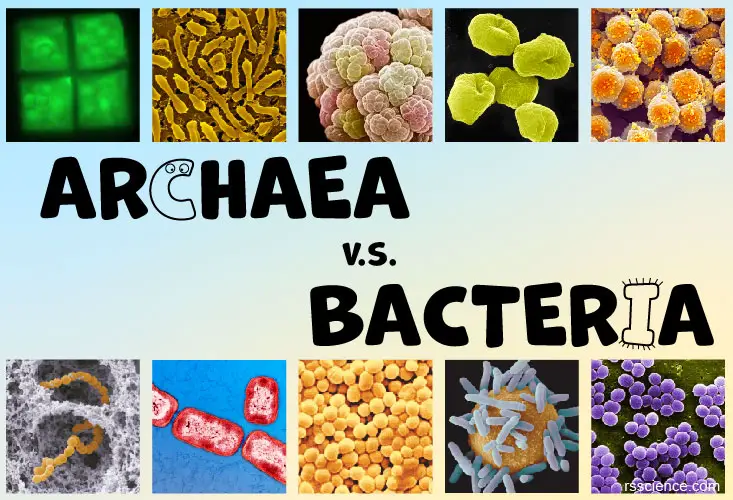Bacteria and archaea are microbes consisting of only a single cell. They are similar in many aspects, including size, shape, reproduction, and habitat. Both are much simpler than eukaryotic cells and are considered to be early forms of life on Earth. However, they also have many differences that eventually separate them into two biological Domains.
What you will learn in this article:
- What Archaea and Bacteria have in common (yes, they share a few features!)
- Why Archaea are considered ancient extremophiles
- How their cell walls, membranes, and genetics set them apart
- A simple side-by-side comparison chart
- Surprisingly, archaea exhibit greater similarity to eukaryotic cells than to bacteria!
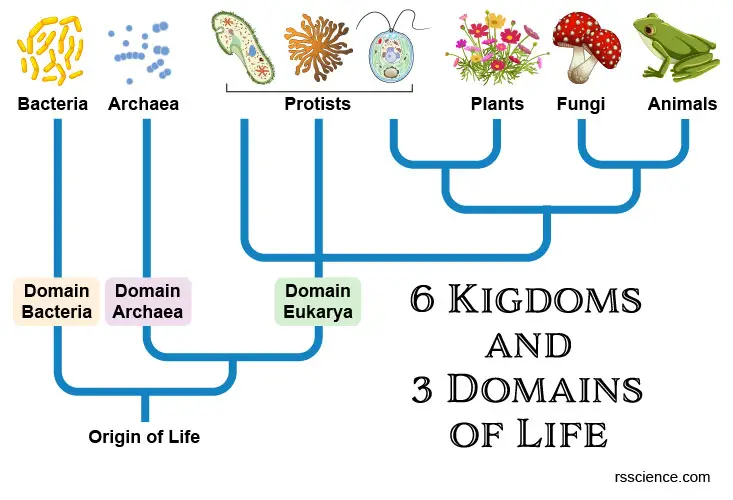
[In this image] Tree of living organisms showing the origins of eukaryotes and prokaryotes. The three-domain system is a biological classification introduced by Carl Woese in 1990 that divides life forms into Archaea, Bacteria, and Eukarya domains.
This article covers
Definition: What are prokaryotes
Prokaryotes (pro-KAR-ee-ot-es) are unicellular organisms that don’t have a membrane-bound nucleus and other organelles. Both bacteria and archaea are prokaryotes.
Learn the differences between Eukaryotes and Prokaryotes below.
Definition: What are bacteria?
Bacteria (singular: Bacterium) are single-celled microbes with cell walls. Bacteria are found almost everywhere on Earth. Some live in or on other organisms, including plants and animals. The human body is full of bacteria; many of these bacterial cells live in the gut and are important for our health. However, some bacteria are pathogenic organisms that can cause illness and diseases.

[In this figure] Diagram showing the cell structure of a bacterium.
Learn more about bacteria by watching the video below.
Definition: What are archaea?
Archaea are a distinct group of single-celled microbes. At first, scientists thought they were just a special kind of bacteria, ie, ancient bacteria. But later, they discovered that Archaea are very different. These differences show that Archaea have been evolving on their own for a very long time—possibly since life first began on Earth.
Some archaea live in environmental conditions considered too extreme for all known life to survive. Some archaea survive high temperatures, often above 100 °C (212 °F), as found in geysers, hydrothermal vents, and oil wells. Others live in icy habitats, highly saline, acidic, or alkaline water. This unique capability gives them a name – extremophiles.
Learn more about archaea by reading the article below.
What do bacteria and archaea have in common?
1. Both bacteria and archaea are prokaryotes.
Bacterial and archaeal cells do not have a membrane-bound nucleus. Their genetic materials (DNA) are within the cytoplasm. They also lack other membrane-bound cell organelles, including mitochondria, chloroplasts, endoplasmic reticulum (ER), and Golgi apparatus. Because of this, all the biochemical reactions, as well as transcription/translation, happen directly in the cytoplasm. This simple cell structure also limits how large they can grow.
2. Both bacteria and archaea are single-cell organisms.
Each bacterial and archaeal cell is an independent organism. Unlike multicellular organisms, they don’t form tissues or organs. That means every bacteria and archaeal cell must handle everything a living organism needs – feeding and reproduction.
3. Both bacteria and archaea like to form a community.
Although bacteria and archaea are single cells, they tend to grow together into a high-density community of cells, called biofilm. Living in a biofilm gives individual cells many advantages. For example, the biofilm matrix protects the cells with high resistance from the penetration of antibiotics.
4. Bacteria and archaea have similar sizes and shapes.
Bacterial and archaeal cells are pretty tiny, only 1-1.5 µm in length. Although some exceptions exist, some bacteria can grow up to 750 µm, while Nanoarchaeota could be as small as 0.4 µm.
Bacteria and Archaea can look very similar in shape. They are found as rods, spheres (cocci), spirals, plates, or coiled. They both have hair-like appendages, such as flagella and pili, on their cell surfaces. Because of these similarities, it is hard to distinguish bacteria and archaea just by looking at their appearance under a microscope.
5. Both bacteria and archaea can be found everywhere on Earth.
Bacteria and Archaea are incredibly adaptable and can live almost anywhere. You can find them everywhere, from the deepest oceans to the highest mountains. The ocean has the most abundant amounts of bacteria and archaea. Some types can survive in extreme places like hot springs, deep-sea vents, salty lakes, and icy waters—these organisms are called extremophiles. Bacteria and Archaea are also common inside our bodies, playing an important role in our health.
6. Both bacteria and archaea can use diverse energy sources.
When life first began, Earth’s environment was much harsher than it is today. Early bacteria and archaea had to find different ways to get energy to survive and to expand their territory. Over time, they developed various strategies: some became phototrophs that obtain energy from sunlight, others became chemotrophs that rely on energy from chemical reactions, and some became organotrophs that live by breaking down organic materials.
Key differences between bacteria and archaea
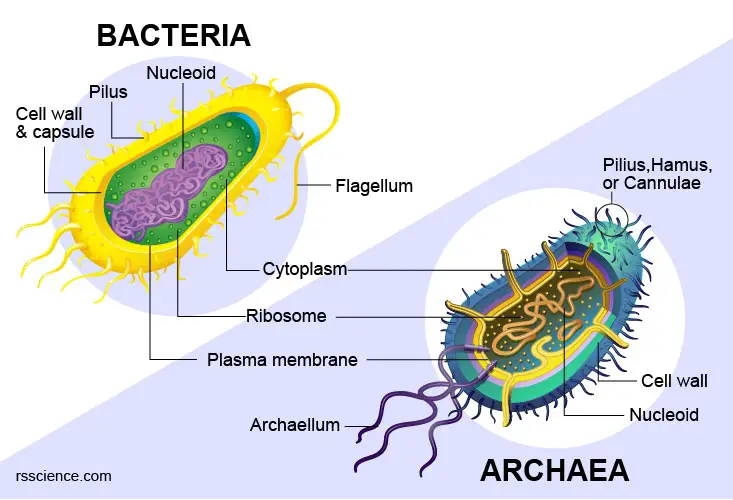
[In this image] Structural similarities and differences between bacterial and archaeal cells.
Although bacterial and archaeal cells are similar, there are several critical differences. These differences are substantial enough to warrant that archaea have a separate domain. See the table below for a summary.
Table: Differences and similarities between bacteria and archaea
| Characteristics | Bacteria | Archaea |
| Cell type | Prokaryotic | Prokaryotic |
| Cell morphology | Sphere, rod, spiral | Sphere, rod, spiral, plate |
| Cell wall composition | Made of peptidoglycan | Made of protein; lack peptidoglycan |
| Cell membrane composition | Ester linked lipids with D-glycerol (straight chain) | Ether linked lipids with L-glycerol (branch chain) |
| Ribosome | 70S ribosomes | 70S ribosomes |
| Flagella | Yes | Archaeal flagella, also termed archaella |
| Pili | Yes | Yes |
| Chromosomal DNA | long, circular form | long, circular form |
| Plasmid | Yes | Yes |
| Unique structures | Capsule | Cannulae and Hamus |
| Reproduction | Fission, budding, and fragmentation; forming endospores | Fission, budding, and fragmentation; no endospore |
| Pathogenicity | Some are pathogens | No |
| Photosynthesis | Some species can do, like cyanobacteria | Some species are phototrophs, but do not perform oxygen-generating photosynthesis |
| Glucose oxidation | Glycolysis and Kreb’s cycle | Do not use glycolysis or Kreb’s cycle |
| Habitats | Many habitats range from soil and water to inside living organisms. A small number are extremophiles. | Many are extremophiles and are found in extreme environments like the deep sea, hot springs, salt brine, etc. Also abundant in the oceans. |
| Examples | Escherichia coli (E. coli) Staphylococcus aureus Bacillus subtilis Pseudomonas aeruginosa Salmonella Typhi Lactobacillus brevis | Sulfolobus tokodaii Haloquadratum walsbyi Nanoarchaeum equitans Methanopyrus kandleri Pyrococcus furiosus Pyrodictium abyssi |
Cell wall
The cell wall is a protective layer that surrounds cells and gives them shape and rigidity. The chemical composition of the cell walls varies between archaea and bacteria.
Bacterial cell walls contain peptidoglycan, composed of polysaccharide chains and peptides. Cell walls are thinner in Gram-negative bacteria than Gram-positive bacteria. Gram-positive bacteria also have lipoteichoic acids, which anchor the cell wall to the cell membrane. Some pathogenic bacteria have an extra thick layer of sugars outside the cell wall, which is called the capsule.
Archaeal cell walls do not have peptidoglycan. The protection is provided by surface-layer proteins, called S-layer. Archaea do not have capsules.
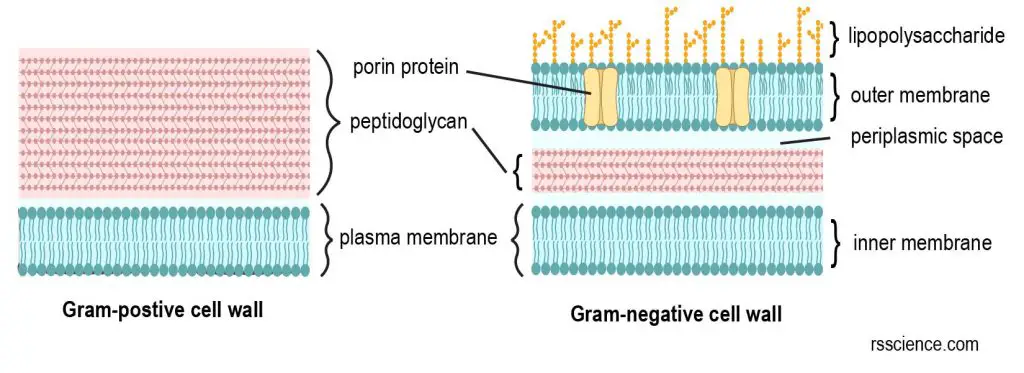
[In this image] Cell walls and membranes of Gram-positive or negative bacteria.
Plasma membrane
Archaeal plasma membranes are made of molecules that are different from those in all other life forms.
In most organisms (bacteria and eukaryote), cell membranes are made of molecules known as phospholipids, which have a phosphate “head” and a lipid “tail”, made of straight carbon chains. But Archaea are different. Their lipid tails are long isoprenoid chains with multiple side branches and rings. These branched chains may prevent archaeal membranes from leaking at high temperatures.

[In this image] Comparison of plasma membrane lipid between Bacteria, Eukarya, and Archaea.
Image source: openstax
Another unique feature of the archaeal membrane is that it is composed of glycerol-ether lipids, whereas bacteria and eukaryotes have membranes composed mainly of glycerol-ester lipids.
Flagella and Pili
Both bacteria and archaea have hair-like structures on their cell surface. The long one is called the flagellum (plural: flagella), while the short one is pilus (plural: pili).
Archaeal flagella are known as archaella (singular: archaellum), which operate like bacterial flagella and are used to propel cells by rotation.

[In this image] A bacterium with three long flagella and many pili covered its cell. This is a 3D illustration of Escherichia coli, not a real picture.
Photo source: Microbiology Society
Cannulae and Hamus
Cannulae and Hamus are two structures unique to archaea. Both are tube-like appendages that can help archaeal cells stay together and attach to a surface. Learn more about Archaea by reading “Archaea – Definition, Structure, Types & Extremophile Habitats”.
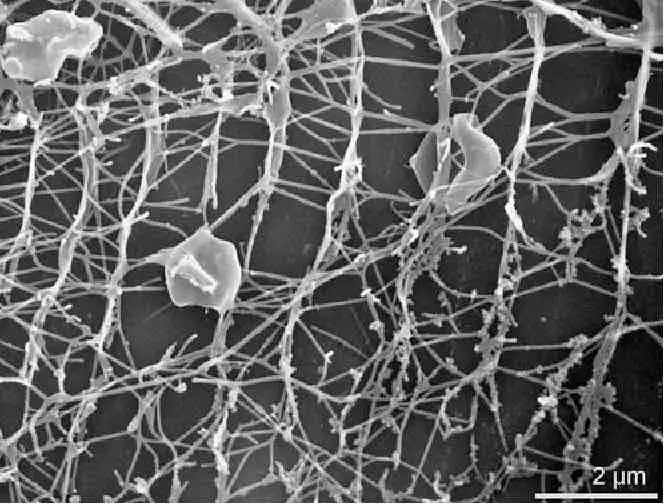
[In this image] Pyrodictium abyssi, disk-shaped archaeal cells, within a web of matrix made up of hollow tubules, the cannulae (Latin: “little reeds”). These cannulae can withstand temperatures up to 135°C.
Image source: Semantic scholar

[In this image] Electron micrograph of Altiarchaeales biofilm (a mass of bacteria or archaea). Cells connect to each other by tube-like appendages called hami. (A) overview, (B) closer view.
Image source: Microbe Wiki
Archaea are closer to eukarya than bacteria
Surprisingly, scientists found that compared to bacteria, archaea in many aspects are closer to eukaryotic cells! You can see the comparison in the table below:
Table: Distinct characteristics between three domains
| Characteristics | Bacteria | Archaea | Eukarya |
| Cell type | Prokaryotic | Prokaryotic | Eukaryotic |
| Nucleus | No | No | Yes |
| Organelles | No | No | Yes |
| Metabolism | Bacterial | Bacterial-like | Eukaryotic |
| Chromosomal DNA | Circular | Circular | Linear |
| Telomers | No | No | Yes |
| Introns | No intron | Some introns | Most genes have introns |
| Histones | No | Have proteins similar to histones | Have histones |
| DNA replication | Bacterial | Eukaryotic-like | Eukaryotic |
| Transcription | Bacterial | Eukaryotic-like | Eukaryotic |
| Transcription start site | Diverse types | Similar to TATA box | TATA box |
| RNA polymerase numbers | One | Several | Several |
| Poly A addition | No | Yes | Yes |
| Translation | Bacterial | Eukaryotic-like | Eukaryotic |
| Ribosome structure | 30S, 50S | 30S, 50S (but look like eukaryote) | 40S, 60S |
| First amino acid in protein synthesis | Formyl-methionine | Methionine | Methionine |
| Binding of ribosome | SD sequence | mRNA cap | mRNA cap |
| Cell wall composition | Made of peptidoglycan | Made of protein; lack peptidoglycan | Not always present Plants: Cellulose Fungi: Chitin |
| Cell membrane composition | Ester linked lipids with D-glycerol (straight chain) | Ether linked lipids with L-glycerol (branch chain) | Ester linked lipids with protein (straight chain) |
In brief, Archaea are structurally more similar to bacteria, but their internal molecular machinery is closer to that of eukaryotic cells. In several aspects related to DNA replication, transcription (DNA to mRNA), and translation (mRNA to protein), archaea resemble eukaryotes more than bacteria. Because of these similarities, some scientists believe that archaea might be the common ancestor of all eukaryotic organisms.
Summary – bacteria vs. archaea
1. Bacteria and archaea are two groups of microbes that belong to Domain Bacteria and Domain Archaea, respectively.
2. However, archaea and bacteria share many similarities as well. They are prokaryotic, single-celled microorganisms with cell walls. Both form biofilms and live everywhere on Earth by adapting to use diverse sources of energy.
3. Unlike bacteria, archaea don’t have peptidoglycan in their cell walls.
4. Archaea have unique cell membranes with branched lipid molecules.
5. Archaea are more like eukaryotic cells than bacteria when it comes to how they copy DNA, make RNA, and build proteins.
6. Some pathogenic bacteria could cause diseases. No archaea are found to be pathogens.
Q&A: Some frequently asked questions are quickly answered here
List five differences between archaea and bacteria.
1. Cell wall – Archaeal cell walls don’t contain peptidoglycan.
2. Cell membrane – Archaea have unique cell membranes with branched lipid molecules.
3. rRNA sequence – Scientists use ribosomal RNA sequences to define the Domains of Bacteria and Archaea.
4. Gene, transcription, and translation – Archaeal genes and the process of transcription/translation are more similar to eukaryotic cells, unlike bacteria.
5. Habitats – More archaea can survive in extreme environments, such as hot springs, deep-sea vents, and salty pools.
What came first, archaea or bacteria?
Archaea are possibly the most ancient form of life. Since bacteria and archaea do not have distinct morphologies, the shape of fossils cannot be used to identify them as bacteria or archaea. However, the lipid composition is very different between bacteria and archaea. Therefore, the chemical fossils (metasedimentary rocks), the oldest known traces of these isoprene lipids, which belong to archaea, have been found in Greenland, dated 3.8 billion years old.
In contrast, the oldest known cyanobacteria-like fossils are nearly 3.5 billion years old. So, according to the fossil record, it seems that archaea came first. But scientists make new discovery every day, you never know when they will discover the bacteria fossil order than archaea’s.
Reference: Allwood, A. Evidence of life in Earth’s oldest rocks. Nature 537, 500–501 (2016).
Do bacteria and archaea have a nucleus?
No, they don’t have membrane-bound nuclei and belong to prokaryotes.
Do bacteria and archaea have cell organelles?
They don’t have membrane-bound organelles such as mitochondria, chloroplasts, endoplasmic reticulum (ER), and Golgi apparatus. However, they have cell walls, cell membranes, cytoplasm, ribosomes, flagella, and pili.
Do bacteria and archaea have ribosomes?
Yes, they have ribosomes of the same size. However, structurally, archaeal ribosomes are closer to Eukarya’s ribosomes.
Do bacteria and archaea have mitochondria?
No, they don’t have mitochondria. They generate energy in the cytoplasm and across the cell membrane.
Are bacteria and archaea harmful?
Some types of bacteria can cause disease, but so far, no Archaea have been found to be harmful. Many bacteria and archaea are beneficial to our health.

